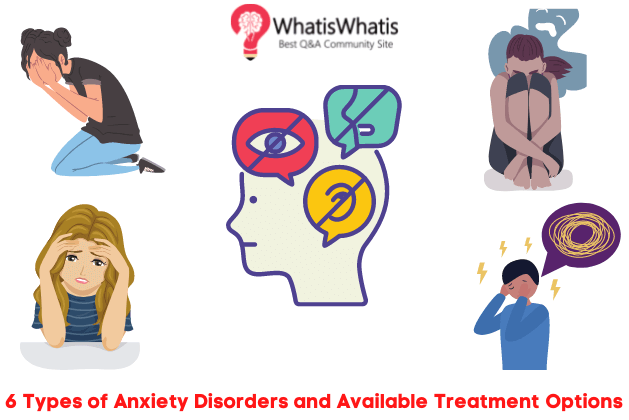Everyone feels anxious every now and then, and that is perfectly normal. For people with anxiety disorders, these feelings are usually very intense and overwhelming and so frequent that they tend to interfere with normal life.
There are several types of anxiety disorders, each characterized by unique symptoms as highlighted below in this post.
Know more: How to Tell Your Doctor You’re depressed
What are the Types of Anxiety Disorders?
1. Generalized Anxiety Disorder (GAD)
This is an anxiety disorder characterized by unprovoked or unreasonable chronic anxiety and excessive tension and worry. This worry goes on for days for at least six months.
In addition to facing difficulty controlling the intense feelings of worry, people with GAD also have the following symptoms:
- Restlessness and feeling on edge
- Difficulty concentrating
- Irritability
- Sleep problems
- Being easily fatigued
2. Panic Disorder
Recurrent panic attacks, accompanied by both physical and emotional distress are the hallmark symptoms of this type of anxiety disorder. These attacks can be unexpected, that is for no particular reason. They can also follow a pattern such as in response to a feared object. They are unexpected and usually last for a few minutes.
Common symptoms during a panic attack include:
- Shortness of breath
- Chest pain
- Sweating
- Dizziness and light headedness
- Shaking and trembling
- Palpitations
- Hot flashes or chills
- Feeling out of control
- Feeling choked up
Panic attacks can be so severe that you may think you are having a heart attack. These attacks may also occur if you have other mental disorders such as PTSD.
3. Social Anxiety Disorder
This type of anxiety disorder was previously referred to as social phobia. A person with social anxiety has an overwhelmingly and intensive fear of being embarrassed, humiliated or rejected in a social interaction. People with social anxiety will do their best to avoid these everyday interactions or endure the interactions with great anxiety.
Examples of these situations include meeting new people, speaking in public or even making small talk with others. This anxiety disorder can manifest in different situations, among people known to you, as well as strangers.
A phobia is an intense or excessive fear of a specific situation or object that others generally wouldn’t consider as harmful. Even when the harm is real, this fear is so intense, but it is also out of proportion to any harm the object or situation may cause.
A person with a phobia will:
- Have an excessive fear of having an encounter with the feared situation or object
- Actively try to avoid the objector situation they fear
- Have intense anxiety when they encounter the feared situation or object
- Endure these encounters with great anxiety
There are different types of phobias and phobia-related disorders such as simple phobias. These include fear of specific animals, fear of water (hydrophobia) fear of flying (aerophobia,) fear of tight spaces (claustrophobia.)
5. Agoraphobia
This particular anxiety disorder occurs in tandem, and in response to a panic attack. A person with agoraphobia will feel extreme anxiety and fear about being in situations where escape may be difficult and help hard to come by when they experience a panic attack.
someone with agoraphobia will experience all this in specific situations including the following:
- When in open spaces
- When in enclosed spaces
- When outside their home on their own
- Standing in a crowd or among others in a queue
- When using public transport
Untreated and severe agoraphobia can get so bad that the person will prefer not to ever leave their house. A person with agoraphobia will actively avoid putting themselves in the situations highlighted, and will require having a companion with them whenever they step out.
6. Separation Anxiety Disorder
Contrary to what many think, separation anxiety disorder is not just for the kids. It is also quite common among adults.
A person, child or adult, with separation anxiety disorder will experience excessive fear about being separated from someone they are attached to. This feeling is considered beyond appropriate for their particular age and may persist for anywhere between a few weeks to a few months.
A person with this type of anxiety disorder will constantly worry about losing the person they are most attached to, and will refuse to do somethings such as sleep or go out without this person. Additionally, most people with separation anxiety disorder will experience nightmares featuring instances where they are separated from this person to whom they are very attached.
Diagnosis and Treatments For Anxiety Disorders:
a qualified mental health professional can accurately diagnose these anxiety disorders. You need only be frank about your symptoms and openly share what’s been happening with both your physical and psychological self.
After an accurate diagnosis, comes developing an anxiety treatment plan that is just right for you. Available anxiety treatment options are as follows
1. Psychotherapy
Also known as talk therapy , this is usually the first recommendation for anxiety treatment. You will start counseling sessions with a qualified mental health specialist. During these sessions, you will work together with your therapist to establish where your anxiety stems from, and find ways to cope with the disorder so it doesn’t stand in the way of normal functioning. You can do individual sessions as well as group sessions.
See this: The Intriguing psychology Behind PEMF Machines
2. Medications
There is a wide range of anti-anxiety medications that your doctor may prescribe for anxiety treatment. These medications work primarily by controlling or balancing the levels of certain brain chemicals, also known as neurotransmitters. Your doctor will adjust your dosage accordingly, depending on how well you respond to the medication.
3. Psychotherapy and Medication Combination
Psychotherapy and medications work well alone, and really great together for anxiety treatment. It usually doesn’t take too long to show improvement with this combination.
Bottom Line
Different people, both children, and adults experience anxiety differently, as evidenced by the various types of anxiety disorders highlighted above. These anxiety disorders can make everyday life from school, to work, and even all forms of social interactions quite challenging. The good news is that there are effective anxiety treatment options that can help you manage your anxiety, allowing you to live your best life.



Leave a comment